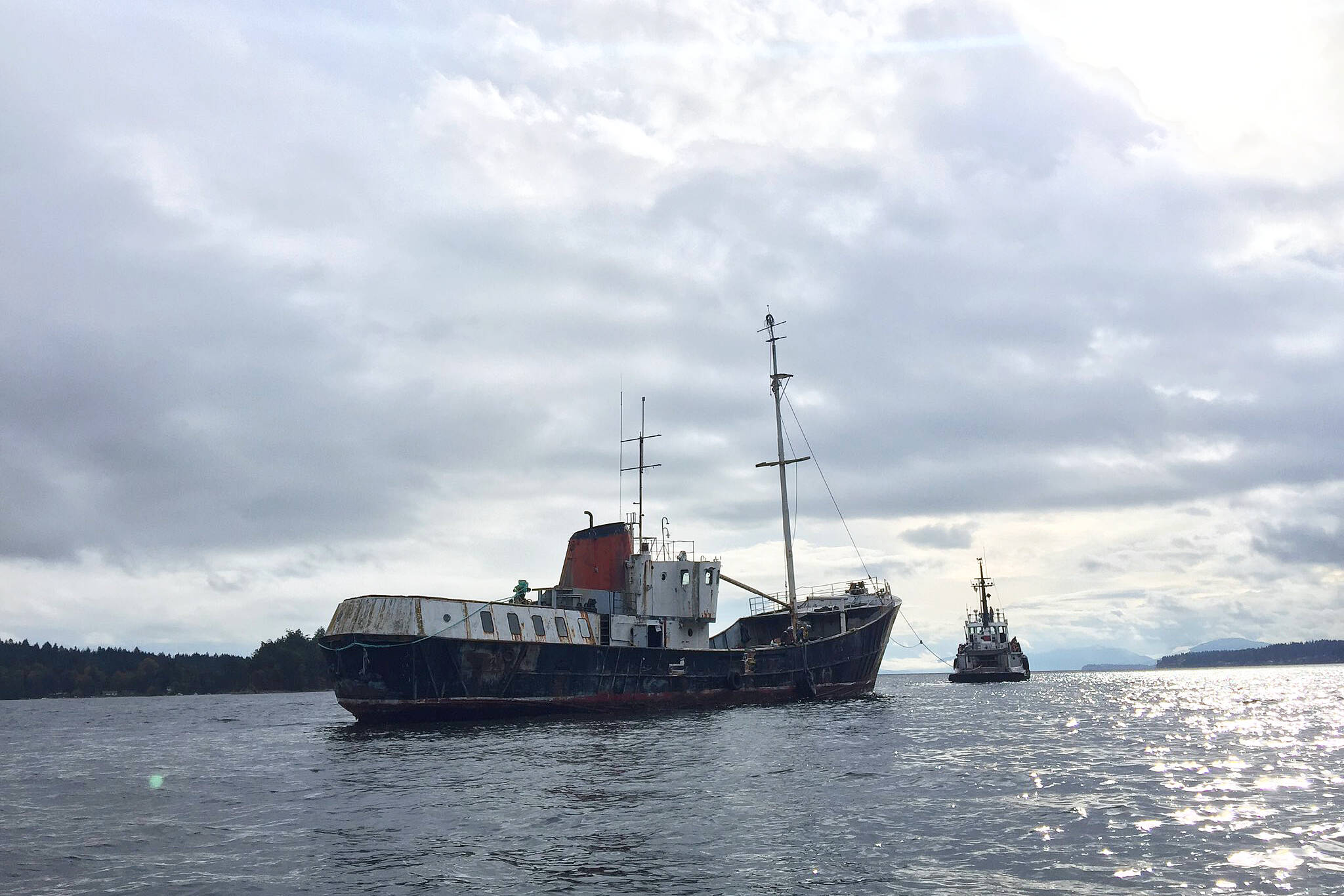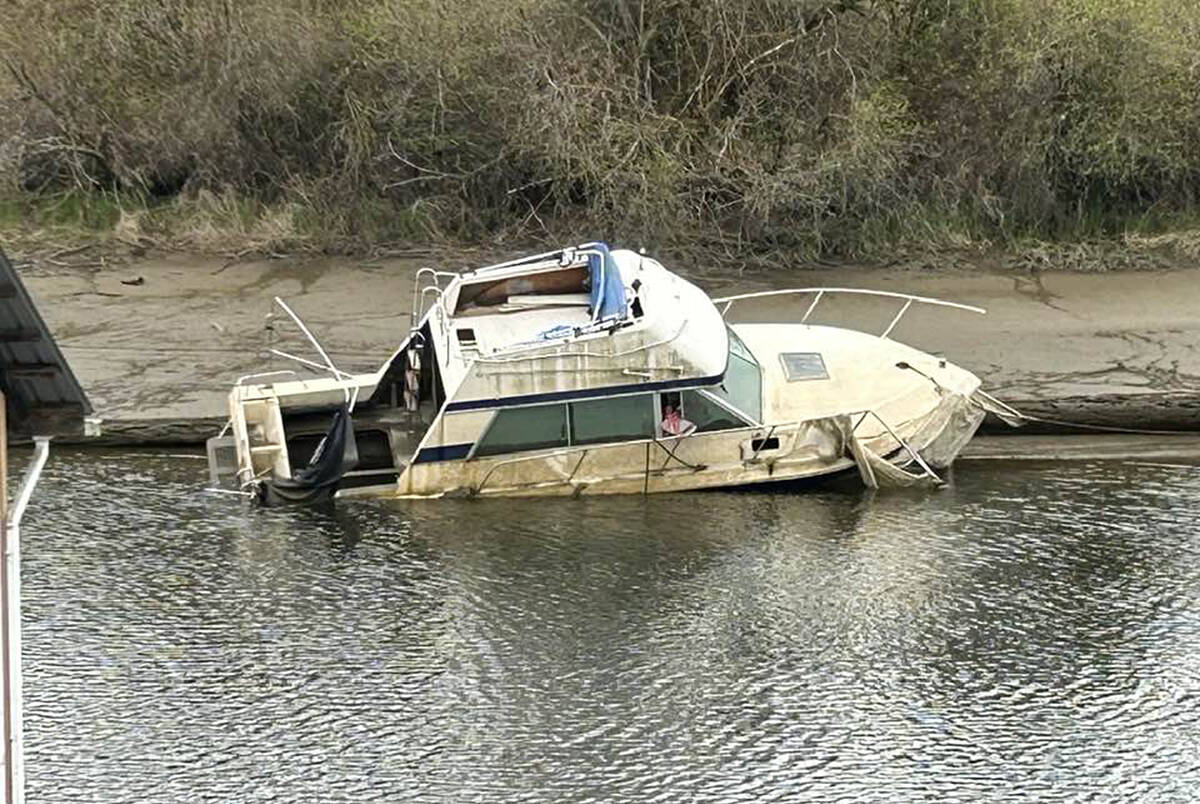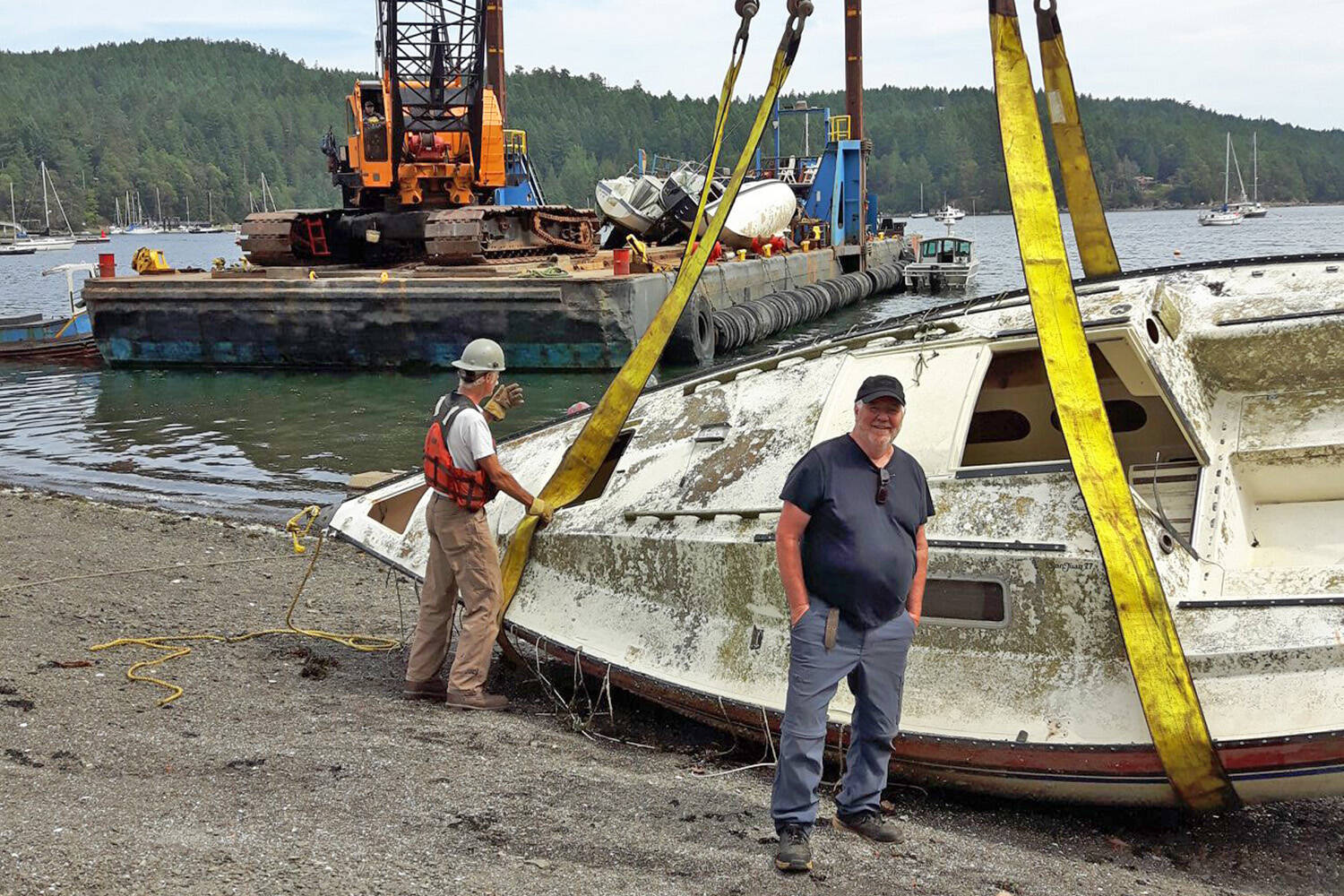This is the third instalment of the Record’s investigative series on the issue of derelict and sunken boats on the West Coast.
In 2019, a federal Bill came into effect to prevent boat owners from abandoning their vessels. Four years later, only two fines were levied. There are at least 5,000 derelict boats in the province’s waters today, polluting the environment and awaiting resolution, according to John Roe from the Dead Boat Disposal Society.
To gain insight into what is being done to fix the problem of derelict boats, this article delves into the governmental protocols for dealing with derelict vessels.
***
On the night of July 16, as flames consumed a beached derelict vessel on Denman Island’s shoreline, local Fire Chief Rob Manering called the Canadian Coast Guard.
He filed an incident report with the government agency, and shared the case number with Liz Johnston, a board member of the Association for Denman Island Marine Stewards (ADIMS).
Initially, Johnston admitted to feeling optimistic, hoping for the prompt removal of the burnt wreck. Her enthusiasm, however, quickly waned giving way to confusion and exasperation.
“When (I contacted the Coast Guard officer), they said that they would get back to me, but they never did,” said Johnston. “They literally blew me off, so we made an official complaint… because it was pretty clear that nothing was happening. It’s all lip service.”
As part of ADIMS, one of Johnston’s goals, along with fellow board member Melanie Hewson, is to help citizens file reports about derelict vessels. However, both women emphasized that the system in place remains complex, confusing, and lacks any sort of comprehensive guidance.
“Normally the best person to do a report is the person who has found (the derelict vessel) because they have all the details and can put in a formal complaint,” said Hewson. “But in most cases, there’s no place that gives you the direct contact information to reach a person. You may send a message but no one knows if it went to the right department and nobody calls you back.”
In an attempt to find answers to her query, Hewson connected with eight governmental agencies.
“It certainly should not fall to the individual to try and resolve the issue themselves,” added Hewson. “It takes a lot of effort and you have to (directly connect with) a person who takes that personal accountability as opposed to someone who’s looking for reasons why it’s not their (responsibility).”
Malcolmson’s solution
Former NDP MP for Nanaimo-Ladysmith Sheila Malcolmson wanted to prevent this very conundrum.
The Gabriola Island resident became an advocate for solutions to vessel abandonment several years before her time in federal politics.
In 2008, Malcolmson was elected chair of the Islands Trust Council and dealt firsthand with this issue endemic to coastal communities across the province.
One particular case involving the beaching of the 187-foot McBarge – a floating McDonald’s restaurant built for Vancouver’s Expo 86 – on the private property of a Galiano Island resident became a defining moment in Malcolmson’s political career.
“(The residents) came to us asking if we could help them solve this problem because they had exhausted every possibility of every government department,” said Malcolmson. “We couldn’t find anybody and interestingly, multiple other local governments… were all hitting dead ends.
“We wanted to have a fast response capability because we recognized that the local fishing and tourism industry was at risk, as well as our marine environment. We also wanted to… prevent the vessels from being abandoned in the first place.”
Determined to bring change, Malcolmson ran for MP and was elected in 2015.
Carrying the work of her predecessor, MP Jean Crowder, the politician proposed her private member’s bill C-352, in which she wanted to amend the 2001 Canadian Shipping Act by providing a national strategy for vessel abandonment.
The brief yet thorough proposal designated the Coast Guard as the primary lead agency responsible for addressing derelict watercraft. Additionally, it aimed to enforce robust legal regulations and implement a mandatory registration system to prevent boat abandonment.
“There was no accountability framework for (people abandoning their) vessels,” said Malcolmson. “It’s a real hole in jurisdiction; a no-man’s land of responsibility that we were attempting to repair.
“What my legislation was aiming to do was to get taxpayers off the hook by fixing boat registration and creating a fund to help cover the cost of vessel disposal. The fact that we’ve had to use taxpayer dollars to pay for those clean-ups… remains a disappointment to me.”
Her bill was quashed by the Liberal’s majority government. Shortly after, the Minister of Transport proposed the Wrecked, Abandoned, and Hazardous Vessel Act (WAHVA).
In short, the WAHVA, in effect since July 2019, made it illegal for boat owners to desert their watercraft, slapping offenders with fines going up to $1 million.
A dual-ministered approach by the Canadian Coast Guard and Transport Canada was chosen to ensure the enforcement of this fledging legal instrument.
However, community leaders and local voices are deploring the seeming inefficacy of this act, veiled in intricate procedures.
Four years after its implementation, only two fines were levied.
The Role of the Canadian Coast Guard
According to Jeff Brady, superintendent of Marine Environmental Hazard Response for the Western Region of Coast Guard, the procedures are simple. Whenever someone witnesses a derelict vessel, they should call the Coast Guard’s reporting desk at 1-800-889-8852, available 24-7.
The person reporting an incident will be asked to provide a detailed description of the watercraft, its location, and any other specific element worth mentioning.
According to Brady, once a report is filed, a deputy officer would be deployed to the scene to determine the severity of the situation.
“The Coast Guard is really the first agency to do an assessment and we deal with emergencies,” said Brady. “(If we determine that this is the case), we immediately start working with our partners and the vessel’s owner (if there is one) to mitigate any type of hazards.”
In the event that the boat poses an imminent threat to public health and/or the environment, Brady stated that the Coast Guard’s response is expedited and is often dealt with within 24 hours.
However, if the circumstances do not call for urgent measures, the case gets handed over to Transport Canada, as well as a variety of local and governmental actors.
“I’m not totally aware of the authorities of all those different levels of government and different organizations and what they have,” said Brady. “There are a lot of people who are involved in the assessment or response of abandoned hazardous vessels.”
When asked about the lack of enforcement, Brady offered “no comment right now.” Nevertheless, he emphasized that respecting WAHVA’s new regulations and educating the public present significant challenges in exercising his authority.
The role of Transport Canada
When Transport Canada receives a new file from the Coast Guard, an additional round of assessments is required to determine if a boat can be identified as abandoned, according to WAVHA’s new regulations.
Subsequently, Ryan Greville, manager of the Navigable Waters Protection Program at Transport Canada, explained that an internal triage ranks the vessels on a list based on their “own sense of urgency.”
If the governmental agency can find the watercraft’s owner, they will try to sort the situation without employing their legal arsenal. Conversely, if they can not trace the proprietor, Transport Canada will take the necessary measures to dispose of the vessel.
Echoing arguments similar to Brady’s regarding the lack of enforcement, Greville added that the vast expanse of B.C.’s waters and the accumulation of boats over the years play a significant role in the seemingly slow response that many criticize.
“We receive an average of 3 to 5 reports of vessels per week. We can’t be everywhere all at once,” said Greville. “Obviously, those we identify as having the highest risk are the ones that are most likely candidates for removal.
“Every assessment is looked at through a particular lens. Because there are (numerous federal and provincial agencies) with different powers, we always have to make a decision about what is the most appropriate action to be taken in each case.”
Greville said one of the greatest challenges at work is the constant pressure of public scrutiny.
“I think one of the big challenges is public expectations versus what our power and authority are,” said Greville. “I think that a lot of people think (that reporting a vessel will make it disappear), but that’s not the case.”
“(People keep calling back) and want to know what’s going on. (Yet, you wouldn’t do this) if you call the police to report something… There’s no public feedback loop built into any of our processes… because when you’re dealing with any kind of enforcement, there are privacy concerns.”
With a yearly operational budget of up to $800,000, Greville and his team can dispose of an average of 70 vessels every year.
However, Malcolmson criticized a similar budget in the past, deeming it insufficient to adequately deal with high-profile cases like the Viki Lyne II – a 107-foot vessel removed from Ladysmith’s harbour in 2016.
“It cost us $1.2 million to remove (this vessel) that the Coast Guard had surveyed as being at risk of sinking,” said Malcolmson. “(At that time), the federal budget that they proposed for abandoned vessel removal was $1 million a year. That wouldn’t even cover a single (case) of that complexity.”
While Greville underlined that high-profile cases represent only a fraction of the numerous vessels littering the province’s waters, he said that Transport Canada currently lacks the funds to address these boats.
“Unfortunately, we don’t always have the money… ahead of time. It’s kind of tricky to set aside $3 million,” said Greville. “Hopefully, that’s one of the things that the vessel remediation fund will do.”
Financed by fines and registration fees, the fund to which Greville alluded, similar to what Malcolmson proposed during her time in office, has yet to be implemented.
The Record will continue monitoring the derelict boat issue and report on any solution-based development.
———
A few weeks after the publication of the second installment of the series, the burnt wreck that initiated this investigation was taken away from the western shoreline of Denman Island on Aug. 26. The next day, another boat, located on the eastern shore, was removed.
FIRST INSTALMENT OF THE SERIES – ‘There are boats everywhere’: Denman Island derelict vessel burns after washing ashore
SECOND INSTALMENT OF THE SERIES – Derelict boats, Part 2: ‘A persistent source of pollution’ in B.C. and beyond






